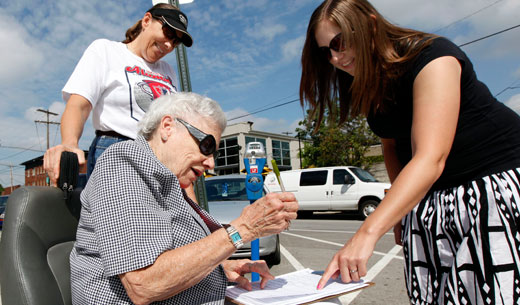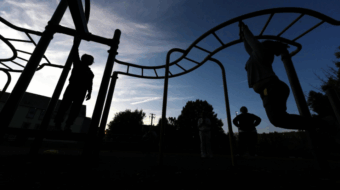
The labor-backed group, Fair Elections Ohio, has submitted almost 320,000 signatures to place the reversal of the state’s new voter suppression law, HB 194, on the ballot.
The move puts the law’s provisions on hold for the 2011 and 2012 election cycles. The number of signatures collected is well in excess of the 231,000 that were required to put the measure up for a vote.
Wade Henderson, president of the Leadership Conference on Civil Rights, said his group is pleased. “HB 194 would have restricted early voting, barred counties from sending out unsolicited absentee ballots and limited the days and ways people can vote before Election Day.”
Experience has been that early voting benefits progressive candidates because it helps guarantee a larger turnout of voters who are poor, minorities, students and people with disabilities.
Stringent requirements for picture identification cards also reduce turnout among voters who have difficulty getting or paying for them.
The Ohio victory against vote suppression follows by a month similar successes in Maine, where voting rights are also under attack by the right. Maine has, for many years, allowed same-day vote registration so that just about anyone who wishes to vote can do so.
On Sept. 9, the coalition Protect Maine Votes announced that Maine Secretary of State Charlie Summers had verified more than enough signatures to allow placement on the ballot of a measure to overturn a right-wing law that eliminates same-day voter registration.
The Maine AFL-CIO was a major part of the coalition effort in that state. “Working people don’t need one more thing on their plates right now,” a federation statement said, at the time. “For workers who do shift work, it is an additional barrier to voting to have to get more time off from work to go in and register to vote before an election.”
The Ohio and Maine laws are just two of many examples of voter suppression bills being pushed across the nation by corporations and right wingers.
Most of the vote suppression bills are contoured to match model legislation provided by the corporate-funded American Legislative Exchange Council. The models provided by ALEC change voting rules and other policies, with the net effect of disenfranchising youth, seniors, people of color, people with disabilities and the poor.
On ALEC’s website, there is a “Voter ID Act” link that is accessible only to members. Campus Progress, however, obtained a copy of the ALEC Voter ID model legislation that provides right-wing politicians with a roadmap for an assault on voter rights.
ALEC suggests requiring state-issued IDs to vote, including birth certificates which are often the most difficult to get. For Texas the group even included copies of handgun licenses.
Since college students often take advantage of same day registration, the ALEC guidelines call for elimination of on-the-spot-registration. To make voting by students even more difficult, ALEC advises eliminating student IDs, even those with photos, from the list of valid IDs.
None of this has stopped civil rights groups and unions from fighting voter suppression and other right-wing measures by ballot initiative.
In June, Ohio workers delivered 1.3 million signatures to put on the ballot a measure overturning Gov. John Kasich’s law taking collective bargaining rights from more than 350,000 public employees.
Photo: Volunteers for Organizing for America get signatures on a petition as part of effort to repeal Ohio’s new elections law, Sept. 9, in Columbus. Terry Gilliam/AP










